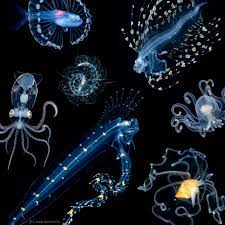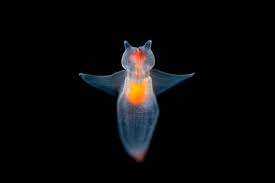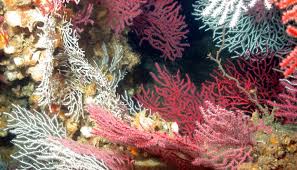About Information
Our Purpose
Like a human body, the importance of the planet’s “blood” (oceans) cannot quite be put into words. In order to keep it flowing, especially now, we must educate ourselves on the immense biodiversity which lives inside. Let’s keep our waters clean; for the future of not only human kind, but also everything which inhabits our planet. It’s hard to believe, but at least 80% of our world’s ocean has not been explored. Usually, as people, we solely focus on the life that’s right in front of us, disregarding the life that lives below. Every bit of plastic that gets carelessly thrown into the water without a thought, could end another life in our precious water. Not only have over 23 animals gone completely extinct within the last 500 years, but over 2,300 marine creatures are currently enlisted as endangered; on the verge of complete depredation. Each and every species in our water is equally important to maintaining the complex ecosystem.
Especially now, as climate change is looming, and our planet is on the brink of destruction, we need to educate the future marine biologists of the world. Please, help us keep our planet sustained, and save the millions of species which inhabit our oceans.

Water is the 𝘣𝘭𝘰𝘰𝘥 of the Earth, but is treated as the waste. Let's change that through education. Together
Marine biologists across the world have determined that there are roughly 2.2 million marine species on our planet. Out of that whopping number, only 240,000 species have been identified. If the math is done correctly, this means that we only are aware of roughly 11% of the marine ecosystem. There are tons of creatures contributing to life, that we are unaware of. This doesn’t even include the number of fresh water species. Added to that, there are over 18,000 freshwater species that are known today. The vastness of our oceans is exceedingly important, and we can start by educating the future marine biologists of the world, to help us uncover what lives on our planet, and keep our precious waters clean and full of life.
The Importance of Marine Biodiversity (What you need to know):
The Effervescent Coral Reef
The most important, however most overlooked species in our oceans, is the coral reef. The coral reefs of the ocean are home to around 25% of all marine species (Millions). Most don’t know this, but the coral reef itself is made out of living things. The beatiful, vibrant coral reefs you see are actually composed of tiny marine creatures known as Coral Polyps . These microscopic creatures join together, secreting Calcium Carbonate (CaCo3). Calcium Carbonate is the same substance used in dietary supplements for humans with weak bones; hence the hard, bone-like structure of coral.
Since 2009, it’s been globally reported that 14% of the ocean’s sacred coral reef has been completely destroyed, or severely impaired. That percentage equates to around 11,000 square kilometers of coral, or 2,059,218 American football fields.
Recent studies have shown that by the next century, if we do not make a change, the beautiful phenomenon of coral reefs may be a thing of the past.
Scientists have also found that modern day coral reefs have been building for around 250 million years, which could all be destroyed in the next century.
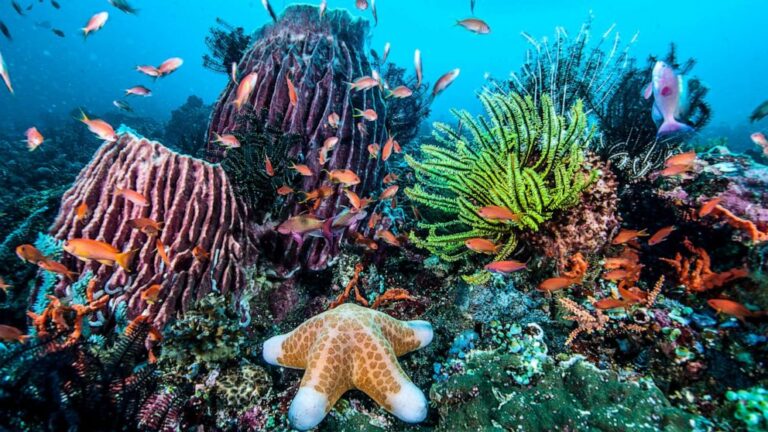
Coral has been found to contain natural anti-inflammatory properties. Dolphins sometimes will rub against coral to protect their skin:
This has inspired human scientists to search for new medicinal properties in coral.
Certain fish (like the tusked fish) use coral to crack open their food for survival!
Coral reefs also serve as an important food source for birds during the dry season.
Those birds serve as a food source for large fish circling the area.
Not only is coral useful to humans, but all sea plants including phytoplankton, sea grass and seaweed produce just as much, if not more oxygen than all plants on land.
Predators in the reef often share a symbiotic relationship to aid each other when catching prey. They work together because they cannot fit into the small crevices in the reef. Example:
Octopus and grouper work together; the grouper tells the octopus where the fish are, and the octopus chases them into the grouper’s mouth. They then swim together, working as a team.
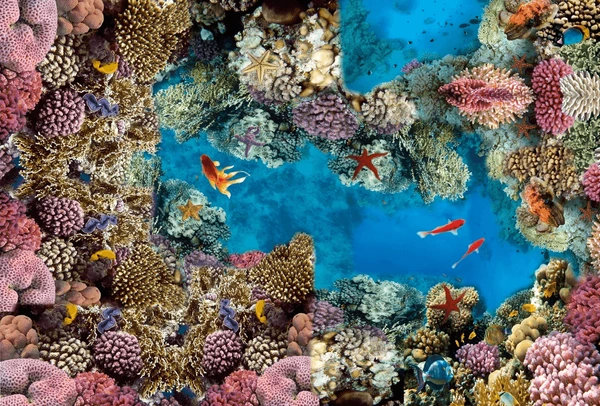
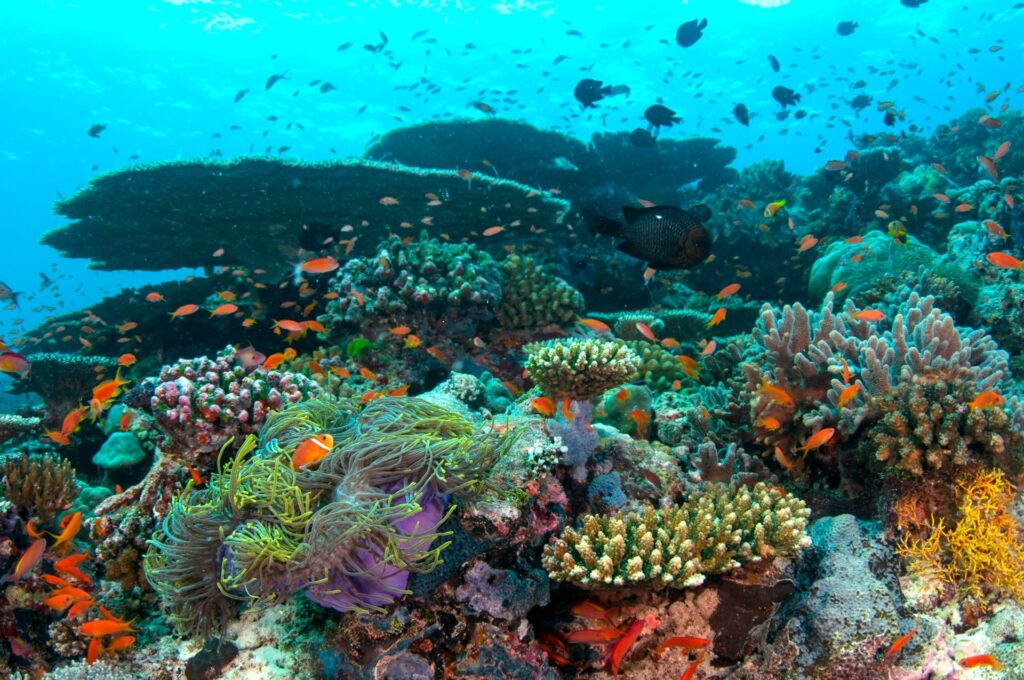
Coral reefs are only a tenth of 1% of the ocean floor, yet contain a fourth of all ocean species.
Predators in the reef often share a symbiotic relationship to aid each other when catching prey. They work together because they cannot fit into the small crevices in the reef.
Example:
Octopus and grouper work together; the grouper tells the octopus where the fish are, and the octopus chases them into the grouper’s mouth. They then swim together, working as a team.
Every creature in the reef has a distinguished role.
For example, sea cucumbers walk along the ocean floor, cleansing
Some creatures come to the coral reef as a form of therapy, or relaxation.
Sea turtles sometimes have designated “cleaning stations” along the reef, where they make a queue to be cleaned by smaller fish such as surgeonfish.
Cleansing stations are thought by scientists to reduce the stress levels of turtles.
Dolphins sometimes surround the reefs, and use stray pieces as play toys.
The Chain Reaction: Anthropogenic Impacts on the Marine Ecosystem
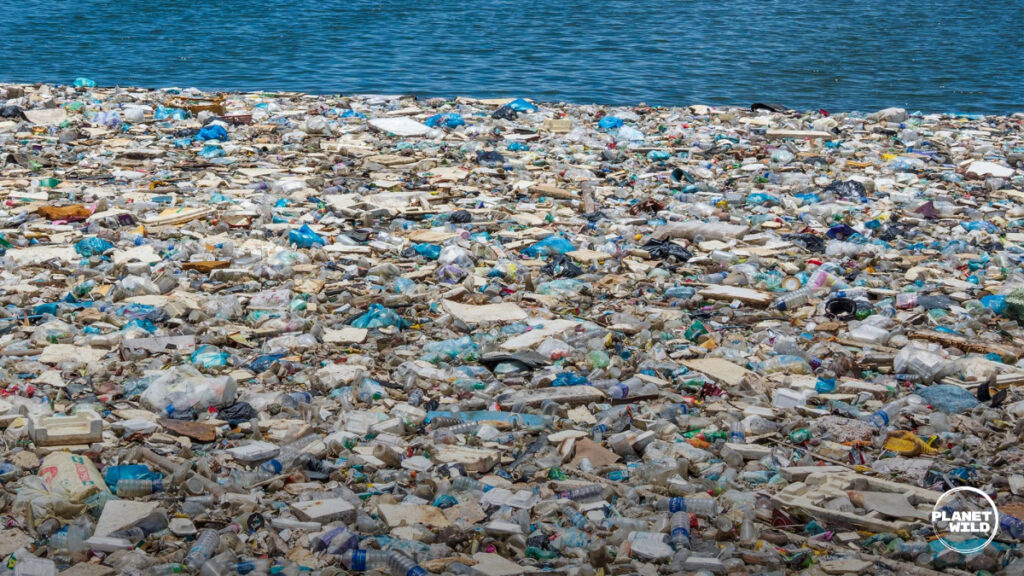

As we increase pollution expenditure into the air, the climate evidentially changes, or the temperature increases. The ocean itself attempts to regulate its own temperature by storing excess amounts of Carbon Dioxide. The over-storing of Carbon dioxide ends up increasing the acidity of the ocean, disabling organisms such as certain shellfish, and coral reefs to build hard shells.
So, not only is coral being stressed out from the increased ocean temperatures, but the ocean temperatures also make it almost impossible for reefs to reform. If we do not stop this now or make a change, the scary, daunting fact is that an estimated 90% of our marine species will be extinct by the twenty-second century if green house gas emissions are not suppressed.
When put into perspective, coral reefs have been found to have lived for 500 million years on this planet. Yet, they have not had an issue since exactly 15 years ago, and since then 14% of all reefs have been lost.
Coral Bleaching
Coral bleaching, unfortunately is a now a common occurence amongst coral reefs. Algae (Scientifically known as Zooxanthellae) often begins to grow in the tissues of coral. When coral is stressed, often due to the higher temperatures resulting in constant climate change, the coral flushes the algae out of its system, it ends up turning completely white, losing its magical vibrance.
Zooxanthellae and coral have a symbiotic relationship. Coral protects the algae, providing it a home within coral’s tissues, while the polyps produce CO2 (Carbon Dioxide) and water for the algae to preform photosynthesis, providing the coral with the energy it needs to remove toxic waste.
The reason for the loss of color is because when the reef flushes the algae when stressed, it simultaneously exposes the white skeleton underneath. This exposure can lead to starvation, and ruination of entire reefs.
As the greenhouse gases we use for our daily life are continuously expended carelessly into the air, the heat from the sun becomes trapped, thus increasing the ocean’s temperature. Everything humans do has a chain reaction, that works its way down the ecosystem.
As an immense amount of marine life lives in these reefs, which includes roughly 4,000 species of fish, the habitat loss that comes with the destruction of coral is immense.
When coral reefs are lost, over one million species are forced to relocate elsewhere, which can be extremely difficult.
Many species who rely on coral reef for their main food source are driven to death from starvation.
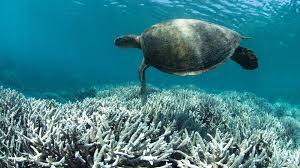
Overfishing
Another serious issue deeply impacting the dense marine biodiversity is overfishing. Most global stocks of the fish humans consume are reported to be overfished, or fished to the maximum point, pushing the limits. 90% of distinct fish populations in which humans consume are at risk of endangerment, and population depletion.
The absolutely terrifying thing is, that already, the worldwide population of predatory fish are already deprecated due to overfishing.
Marlin, Tuna, Swordfish, Sharks, Cod, Halibut, Rays and other species are currently being killed to the point of population depletion.
Not only does overfishing deplete these key species, but the absence of predatory fish imbalances the marine ecosystem, and causes a boom in smaller fish populations, which can lead to the depletion of those small species food sources, like coral reefs, sea grass, and other essential sea plants.
The loss of large predators also can cause invasive, harmful species such as the Lionfish to start disrupting the ecosystems further.
The land animals are also affected, as predatory birds and marine mammals lose a large source of their food.
Loose, or lost fishing nets from large boats have proven extremely harmful to marine animals, as they are hard to detect through their eyes. Recently, an increase of animals like whales, turtles and dolphins getting tangled in fishing nets has occurred. This can lead to suffocation, or permanent scars.
Fishing nets also greatly contribute to the plastic pollution problem in the ocean, releasing toxic waste and microplastics, which can harm any creature (including humans) when ingested.
These toxins also contribute to the looming threat of ocean acidification, which is making it more and more difficult for shellfish and coral reefs to form their bonelike structures, due to the eroding it causes of calcium carbonate.
Coral Reproduction
Despite all human attempts to completely destroy the beauty of the underwater world, which we may only ever explore 5% of, nature has its miraculous ways of repairing itself.
Annually, and In complete synchrony, entire coral reefs produce “eggs”, and those millions of eggs drift away, being swept through the oceans. When they settle, they are able to regrow entire reefs, and populations.
(The polyps of the reef produce millions of eggs annually, which synchronizes with the lunar cycle (the moon))
The coral larvae drifts along ocean currents before settling down to start crowing reefs.

What is Known About Under Water Mountain Ranges:
- We are only now discovering how the creatures of the sea utilize under water mountain ranges.
- Whale Sharks, who are as big as small airplanes, and weighs over 20 tons (check)
- Whale Sharks can give birth to hundreds of live young at a time.
- Scientists still do not know where whalesharks give birth.
- Hundreds of whale Sharks at a certain time of year assemble around Darwin island, a part of the Galapagos.
- At the same time, thousands of female hammerhead sharks assemble around Darwin Island.
- Biologists suspect that the reason for these gatherings is because they are shark breeding grounds.
- Other sharks use the rough skin of whale sharks to rid themselves of aprasites by rubbing themselves up against the whale shark.
- This island is thought to be the “nursery” of the largest marine fish.
The Mysterious; the Deep Sea
Believe it or not, the deep sea holds more life than anywhere else on the planet Earth. However, currently scientists know more about the surface of mars than the life which inhabits the deep.
Out of the 2.2 million suspected species, the deep sea is thought to hold 90% of the ocean’s fish.
In fact, there are more species of Coral in the deep sea than anywhere else in the world, including the shallow water coral reefs along the land coasts.
A Couple Fun Species:
Fang tooth fish: Largest tooth size of any fish(most ferocious fish in the midnight zone)
Deep sea jellyfish and sea cucumbers feed on “marine snow” that comes to the midnight zone from up above.
Six gill sharks- Deep sea sharks, which can go over a year without eating anything
Sea pigs: Simple creatures, yet which can survive under pressure which equates to the power of 50 jumbo jets, and little to no food.
Ethereal Snail fish: The deepest living fish in the world.
The Midnight Zone:
The Midnight zone, or the bathypelagic zone, is the very bottom of the ocean, which is truly dark. No sunlight is able to reach this deep down into the ocean, which is around 4,000 meters, or 13,100 feet down.
Animals in the midnight zone use their crucial adaptation, bioluminescence for all forms of communication. (Mating, fending off predators), because the darkness that deep is absolute.
Down in the deepest part of the ocean, organisms main food source is marine “snow”, or particles which float down above from deceased organisms and various debris.
The “snow” takes thousands of years to form a deep sea bed up to a kilometer thick.
Down in the deep, there are many “deep sea reefs”, or octocorals, which some are estimated to be around 40,000 years old.
Over fishers are ruining the countless, important species that dwell in the deep. Now, much of the deep sea reefs lie in ruins.
Since the 1950s, half of all living coral reefs have been completely destroyed.
There is nowhere in the deep sea with no life. It’s suspected that life on earth began in the deep sea.
3 quarters of the planet’s volcanic activity occurs in the deep.
We now know that hydrothermal vents, the suspected start of life on earth, actually contain more biodiversity than rainforests on land. A square meter of one contains nearly half a million different species of marine life.
Due to deep sea mining, these millions of year old hydrothermal vents are at risk, with 62% of deep sea hydrothermal creatures being endangered.
